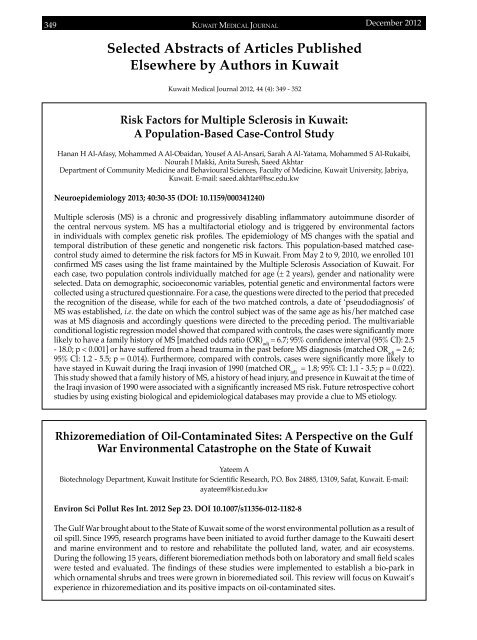Vol 44 # 4 December 2012 - Kma.org.kw
Vol 44 # 4 December 2012 - Kma.org.kw
Vol 44 # 4 December 2012 - Kma.org.kw
You also want an ePaper? Increase the reach of your titles
YUMPU automatically turns print PDFs into web optimized ePapers that Google loves.
349<br />
KUWAIT MEDICAL JOURNAL<br />
<strong>December</strong> <strong>2012</strong><br />
Selected Abstracts of Articles Published<br />
Elsewhere by Authors in Kuwait<br />
Kuwait Medical Journal <strong>2012</strong>, <strong>44</strong> (4): 349 - 352<br />
Risk Factors for Multiple Sclerosis in Kuwait:<br />
A Population-Based Case-Control Study<br />
Hanan H Al-Afasy, Mohammed A Al-Obaidan, Yousef A Al-Ansari, Sarah A Al-Yatama, Mohammed S Al-Rukaibi,<br />
Nourah I Makki, Anita Suresh, Saeed Akhtar<br />
Department of Community Medicine and Behavioural Sciences, Faculty of Medicine, Kuwait University, Jabriya,<br />
Kuwait. E-mail: saeed.akhtar@hsc.edu.<strong>kw</strong><br />
Neuroepidemiology 2013; 40:30-35 (DOI: 10.1159/000341240)<br />
Multiple sclerosis (MS) is a chronic and progressively disabling inflammatory autoimmune disorder of<br />
the central nervous system. MS has a multifactorial etiology and is triggered by environmental factors<br />
in individuals with complex genetic risk profiles. The epidemiology of MS changes with the spatial and<br />
temporal distribution of these genetic and nongenetic risk factors. This population-based matched casecontrol<br />
study aimed to determine the risk factors for MS in Kuwait. From May 2 to 9, 2010, we enrolled 101<br />
confirmed MS cases using the list frame maintained by the Multiple Sclerosis Association of Kuwait. For<br />
each case, two population controls individually matched for age (± 2 years), gender and nationality were<br />
selected. Data on demographic, socioeconomic variables, potential genetic and environmental factors were<br />
collected using a structured questionnaire. For a case, the questions were directed to the period that preceded<br />
the recognition of the disease, while for each of the two matched controls, a date of ‘pseudodiagnosis’ of<br />
MS was established, i.e. the date on which the control subject was of the same age as his/her matched case<br />
was at MS diagnosis and accordingly questions were directed to the preceding period. The multivariable<br />
conditional logistic regression model showed that compared with controls, the cases were significantly more<br />
likely to have a family history of MS [matched odds ratio (OR) adj<br />
= 6.7; 95% confidence interval (95% CI): 2.5<br />
- 18.0; p < 0.001] or have suffered from a head trauma in the past before MS diagnosis (matched OR adj<br />
= 2.6;<br />
95% CI: 1.2 - 5.5; p = 0.014). Furthermore, compared with controls, cases were significantly more likely to<br />
have stayed in Kuwait during the Iraqi invasion of 1990 (matched OR adj<br />
= 1.8; 95% CI: 1.1 - 3.5; p = 0.022).<br />
This study showed that a family history of MS, a history of head injury, and presence in Kuwait at the time of<br />
the Iraqi invasion of 1990 were associated with a significantly increased MS risk. Future retrospective cohort<br />
studies by using existing biological and epidemiological databases may provide a clue to MS etiology.<br />
Rhizoremediation of Oil-Contaminated Sites: A Perspective on the Gulf<br />
War Environmental Catastrophe on the State of Kuwait<br />
Yateem A<br />
Biotechnology Department, Kuwait Institute for Scientific Research, P.O. Box 24885, 13109, Safat, Kuwait. E-mail:<br />
ayateem@kisr.edu.<strong>kw</strong><br />
Environ Sci Pollut Res Int. <strong>2012</strong> Sep 23. DOI 10.1007/s11356-012-1182-8<br />
The Gulf War brought about to the State of Kuwait some of the worst environmental pollution as a result of<br />
oil spill. Since 1995, research programs have been initiated to avoid further damage to the Kuwaiti desert<br />
and marine environment and to restore and rehabilitate the polluted land, water, and air ecosystems.<br />
During the following 15 years, different bioremediation methods both on laboratory and small field scales<br />
were tested and evaluated. The findings of these studies were implemented to establish a bio-park in<br />
which ornamental shrubs and trees were grown in bioremediated soil. This review will focus on Kuwait’s<br />
experience in rhizoremediation and its positive impacts on oil-contaminated sites.
















